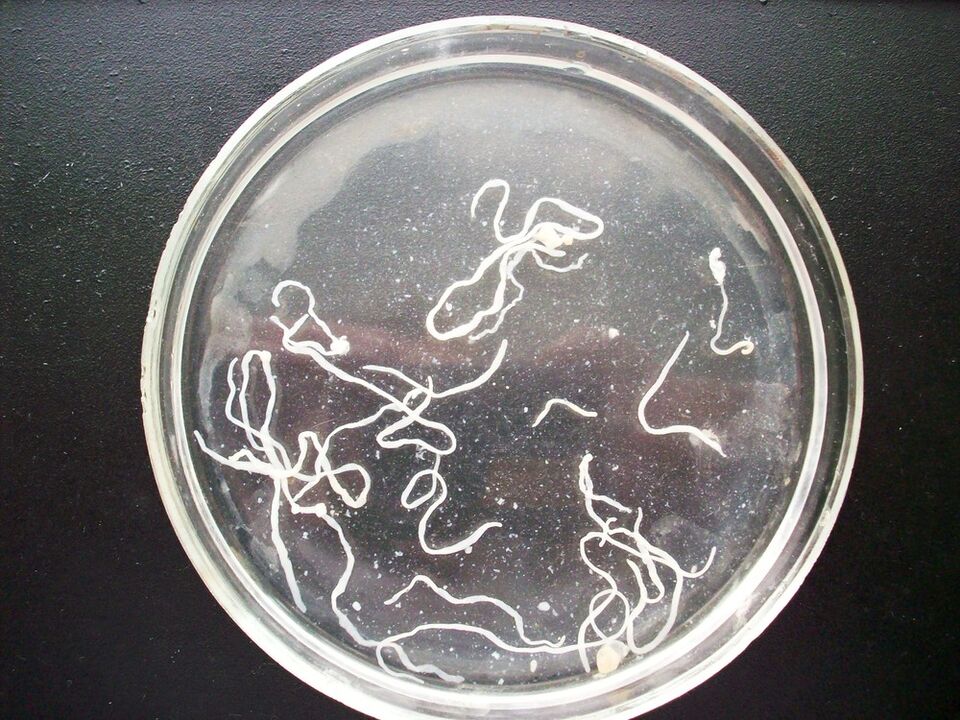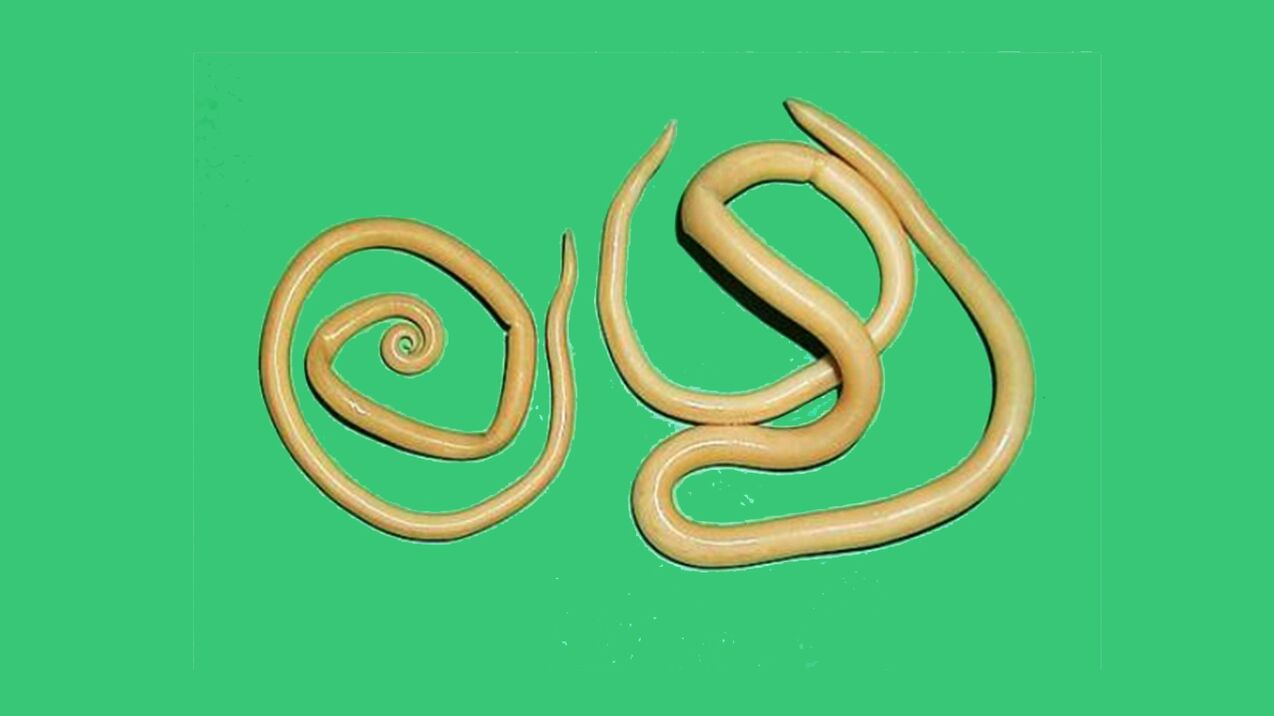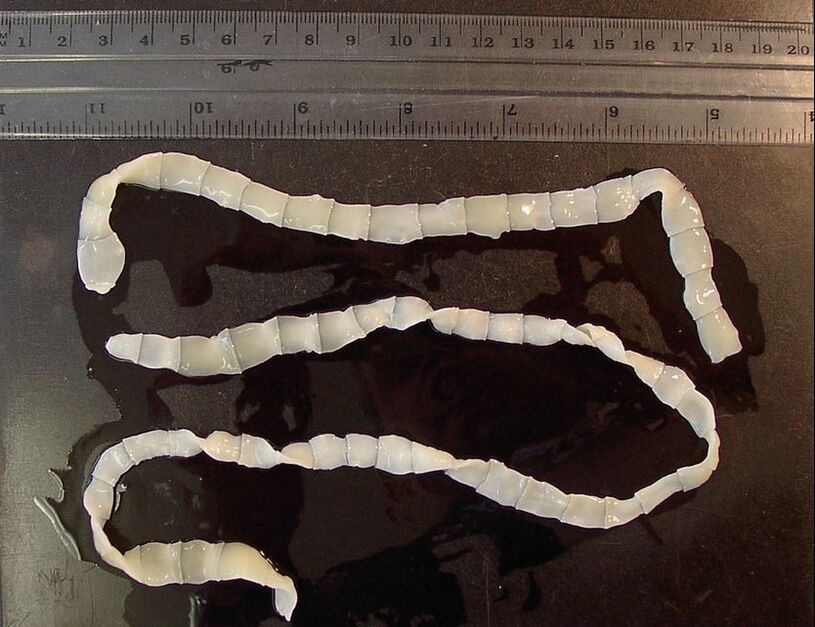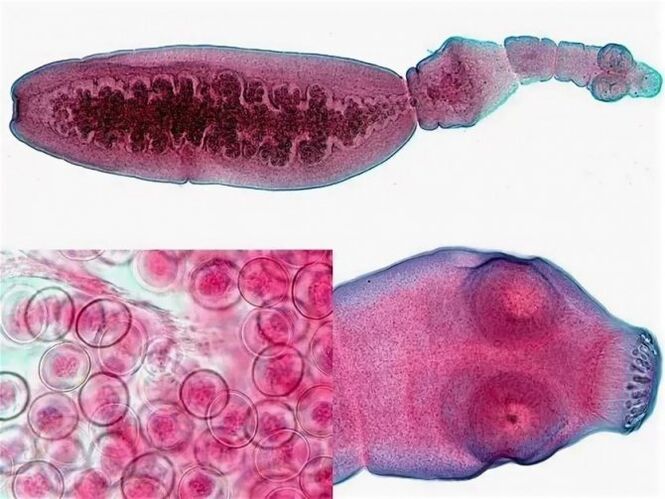
Pinwormis a frequent guest in children's groups. This is a medium-sized (up to 1 cm long) resident of the small and large intestines that lays eggs and leaves the rectum, on folds of skin, underwear, and bedding. This happens more often at night, accompanied by severe itching in the anus. Pinworm eggs ripen in 4-6 hours and are ready to cause disease. They are perfectly preserved in the environment. They invade the human body with dust, dirty hands, soft toys, underwear and dishes.
>If pinworm eggs are found, the entire family of infected people should be examined.
Worldwide around 350 million people are infected with enterobiasis. If a family member is infected, the risk of illness for all households is very high.
Toxocara - a parasite
Toxocarais a parasite in the digestive system of dogs. In the US and Europe, 80% of puppies and more than 50% of adult dogs have toxocariasis. Human surveys have shown that up to 37% of the population are sensitized to the Toxocara antigen. This means that these people were or are carriers of Toxocara.
Toxocara is up to 30 cm long and lives in this form in the body of its permanent owner - a dog. The dog sheds Toxocar eggs in the sand and soil where they can persist for several years. With the sand, they fall into the hands of children who play in the sandboxes and also stick to shoes and clothes. Penetrating a person is a dead end for the parasite, as the larvae mature, spread through the vessels and internal organs, but do not attract attention.
To make a diagnosis, a stool analysis is not at all meaningful. A biopsy of the affected organs (usually the liver) and immunological tests are needed.
Most tragically, Toxocar drifting into the eyes (15% of the cases of eye removal in the world are due to Toxocara), lesions of the lungs, heart, brain and muscles are also uncomfortable - fever, cough, enlargedLiver, inflammation of the lymph nodes, rashes, nervous and mental disorders, convulsions.
Ascaris - a parasite

Ascaris- affects up to 100 million people every year. It gets into a person with food (usually uncooked herbs, vegetables and fruits), raw water, dirty hands, dust, and is actively carried by flies. The length of the roundworm is up to 40 cm, a female roundworm secretes up to 200, 000 eggs daily, which get into the ground and are well preserved there for years. The ingested roundworm egg turns into a larva in the small intestine, then penetrates the intestinal wall, gets into the blood capillaries, is transported to the liver, brain, eyes, heart and lungs. During the process of movement, roundworms feed on blood - erythrocytes and nutrients. Anemia (anemia) is a common companion of ascariasis.
The migration of larvae causes allergies, pain in the whole body, fever, increased risk of asthma, arthritis, neurodermatitis, eczema and seizures in humans. If it gets to the lungs due to a ruptured blood vessel, bleeding and hemoptysis on X-rays are possible - infiltrates like in a tuberculous process.
On the way along the bronchi to the pharynx, roundworms get into the mouth with expectoration and from there into the esophagus, stomach and intestines. Roundworms remain in the intestine and lie against the intestinal walls and cause inflammation, infiltration and bleeding. Complications are possible if the roundworm gets into the sinuses, liver, biliary tract, pancreas, and kidneys. There are intestinal obstruction, suppurative processes in the abdominal cavity. Diagnosis is based on analyzes of stool (at least three times), immunological tests - in the larval period.
Hookworm - a parasite
hookworm- can enter a person through the skin when walking barefoot (it leaves no trace), as well as through the mouth like a roundworm. Hookworm sizes - up to 1. 5 cm, migrate and harm like roundworms. A feature is such a symptom as an itchy rash on the limbs and more pronounced anemia.
As with most invasions, stool analyzes must be performed at least three times.
Broad band - Parasite

Broad tapewormis a large long-liver,the length of an individual is up to 10 meters, the lifespan in the human body is up to 25 years.Can you imagine what happens inside a person when there are several centenarians as tall as this?
Imagine how the worm is twisted in the intestine, how little space is left in the lumen of the human intestine! If the worm "straightened up", half of its length would hang! By the way, the worm absorbs all the necessary and useful substances for itself on the entire surface of the body.
You can get infected by eating raw, insufficiently salted fish, crabs, and caviar. Symptoms of the presence of a tapeworm can include anemia, exhaustion, abdominal pain, especially signs such as increased salivation in the morning, vomiting, nausea, weakness, lethargy, and drowsiness should be alerted. Intestinal obstruction is possible.
A completely amazing effect on an unprepared person is produced by the release of the severed "tail" of the parasite from the intestines - this is a feature of tapeworms that helps in diagnosis.
Beef and pork tapeworms are parasites
Beef and pork tapeworms are parasites that enter the human body with raw meat, meat products and lard.
The length of an adult bovine tapeworm is up to 7 meters, that of a pork tapeworm is up to 2 meters, the lifespan up to 20 years and the main danger is the migration of larvae that are capable even into the eyesand invade the brain.
Echinococcus and Alveococcus - parasites

Echinococcus and Alveococcus are parasites in which a person becomes infected through contact with animal carriers, drinks contaminated water, and swallows soil with berries and vegetables.
The larvae from the intestine are transported through the body by the bloodstream and reach the liver, lungs, kidneys, bones and brain. The larva turns into a cyst that grows by squeezing and squeezing the surrounding tissue. Symptoms depend on the location of the cyst and the degree of compression of the organs.
Cyst rupture is a very serious complication.
Giardia - a parasite
Giardiais the simplest parasitic animal of the flagellate class. It is pear-shaped, 10-20 µm long; The dorsal side is convex and the ventral side is concave and forms a suction cup for temporary attachment to the epithelial cells of the host intestine. 2 oval nuclei, 4 pairs of flagella. It lives in the human intestine (mainly in children), mainly in the duodenum, less often in the bile duct and gallbladder, and causes giardiasis. Asymptomatic parasitic carriers are common. Cyst infection occurs when protozoa enter the lower intestines through the mouth, contaminated food or water enter the body, dirty hands, etc. The incidence is sporadic. Giardiasis is common in all parts of the world.





































